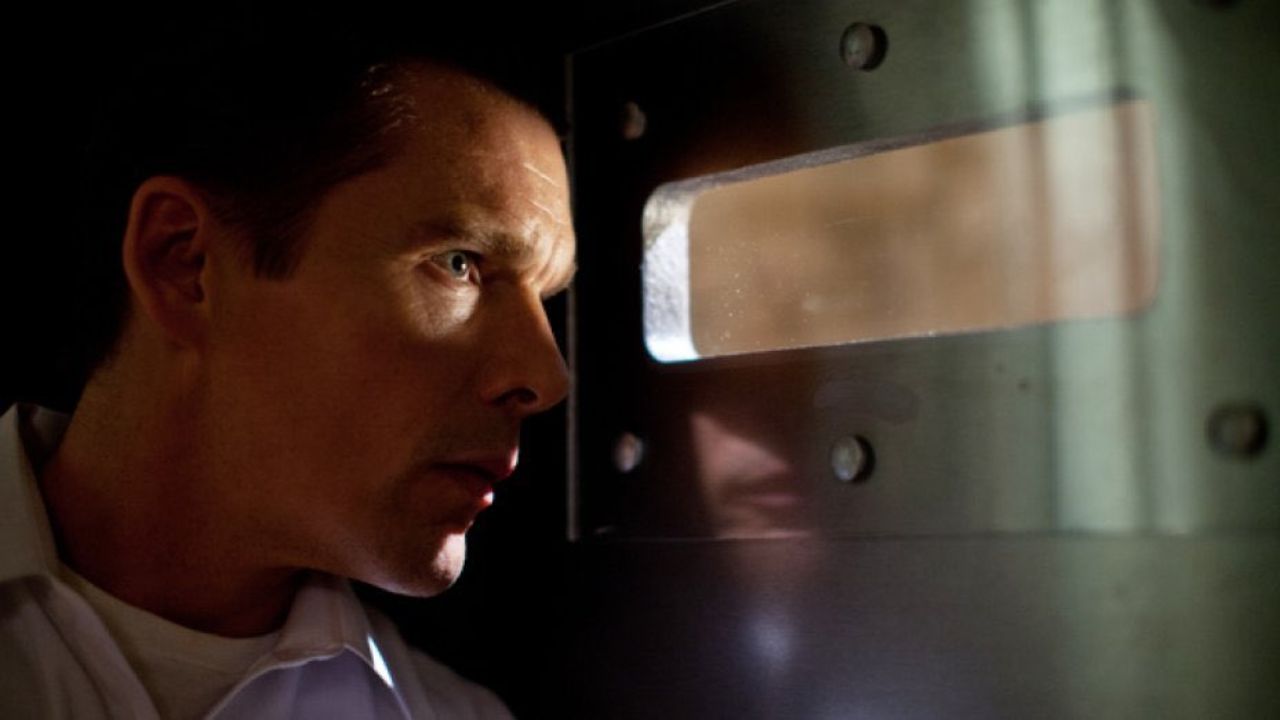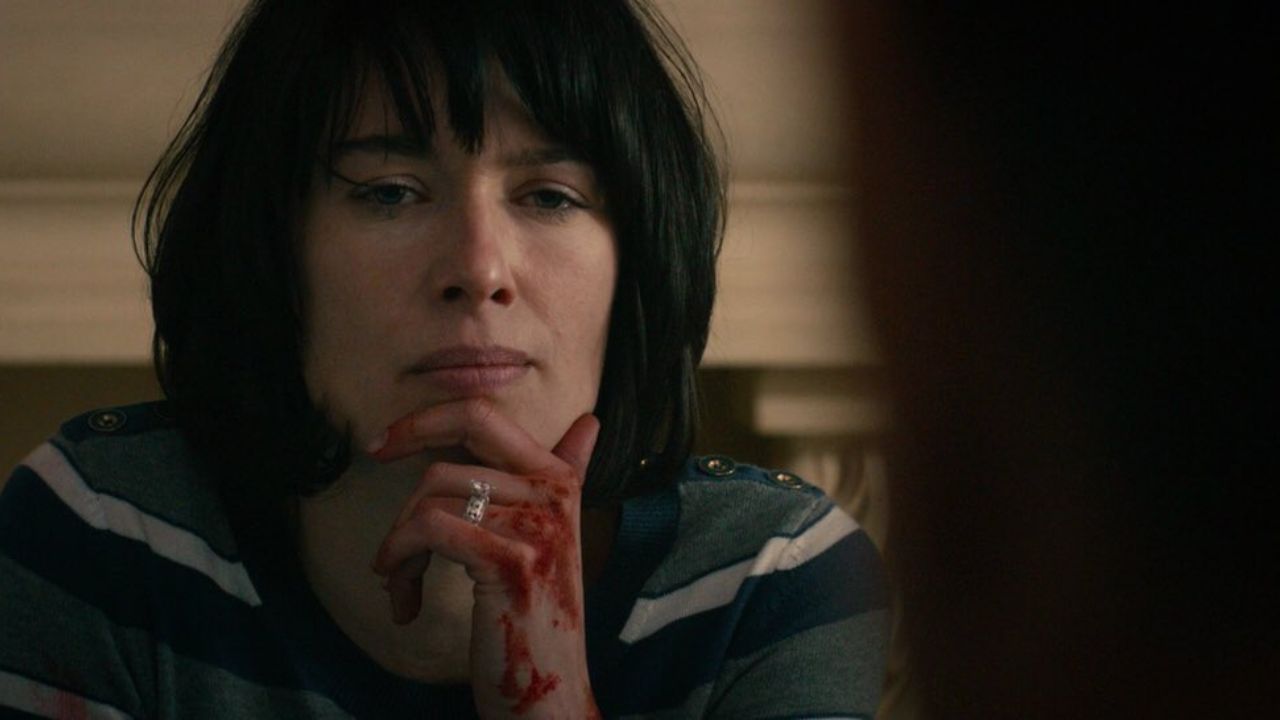This post includes a plot summary and an explanation about the ending of the film “The Purge” (2013). Beware of spoilers.
Directed by James DeMonaco, the action horror film stars Ethan Hawke as James Sandin and Lena Headey as Mary Sandin.

The film “The Purge” is set in a dystopian future where the government has legalized all crimes for one night every year. James Sandin is a successful salesman of security systems. His business made him really wealthy, allowing Sandin to live in a nice neighbourhood with his wife (Mary) and his two kids (Zoey and Charlie). However, their safety is compromised when Charlie lets a homeless man in during “The Purge”.
What Happens in “The Purge”? (Plot Explained)
When Charlie saw a man being chased by a group of masked killers, he decided to open the gates of his house to let the stranger in. Now, the parents have to face the following dilemma: surrender the stranger to the killers or defend him and themselves from the attackers.
Despite possessing a robust security system to protect them from the violence outside, the Sandins are not immune to danger. The masked killers are doing everything in their power to break into the Sandins house. Meanwhile, there is another uninvited guest in the house: Henry, Zoey’s boyfriend. The young man tries to shoot James, but the latter fights back and kills him.
Shortly after, the Sandins capture the homeless man, but they have a change of heart and decide to fight against the invaders. A violent struggle ensues, during which James and Mary kill several attackers. However, the leader ambushes James and fatally stabs him. As the man prepares to kill Mary and her children, her neighbours intervene and kill him.
Plot Twist: Mary’s neighbours are not trying to help her, but to kill her. They accuse the Sandins of flaunting their wealth. The money they made from selling the security systems to their neighbours.
Just when the neighbours were about to execute Mary and her two children, the homeless man intervened and stopped them. Mary decides not to kill the neighbours and everybody waits in silence for the end of “The Purge”. When the time came, Mary ordered her neighbours to leave her house.
The Ending of “The Purge” Explained
The ending of “The Purge” shows Mary’s neighbours returning to their regular behaviour. Before leaving, the homeless man expresses gratitude for the Sandins. Meanwhile, James’ family quietly mourns his loss as the television news report the success of “The Purge”.
There are two main turning points in “The Purge”: the moment when the Sandins decide to fight back against the masked killers and when Mary finds out that her neighbours don’t have her best interests at heart. As a matter of fact, the Sandins’ neighbours hate them for making a fortune at their expense.
Up until the incident, the Sandins were rather supportive of “The Purge”. However, when bad things started to happen to them, the Sandins realized that they too have been complicit. In other words, many wealthy individuals like the Sandins have been living in a bubble of privilege and ignorance. To a certain extent, they thought their lives were more valuable than others’.
Unfortunately for the Sandins, they had to learn the hard way that material success incites a lot of jealousy and resentment in people. Their neighbours, who the Sandins thought were friends, are a prime example of that. Although Mary and her children survived the night, they will never see the world or their neighbours the same way again.

So what does the ending mean? The ending of “The Purge” exposes the hypocrisy and brutality of a lawless system that benefits the rich and punishes the poor. As the story unravels, “The Purge” no longer seems to be a means to release pent-up aggression and reduce crime, but rather a tool for the rich and powerful to eliminate the poor and marginalized. Basically, many engage in “The Purge” for their own benefit and interests.
The Purge Discussion
There is some social commentary in “The Purge”. The film is essentially an allegory that satirizes the wealth gap between the rich and the poor. It highlights the possible social implications of that system and shows the ugly side of humans when facing those same challenges.
“The Purge” is essentially a night where people vent out their frustrations or act upon their darkest desires. For instance, Mary’s neighbours used the event to break into her house to execute her family because they were “upset” at their meteoric rise over the last couple of years.
Then, there are people who don’t belong to the elites, such as the masked killers, but somehow they still want to feel superior. As a result, during “The Purge”, they chase down a poor homeless man who had no means to defend himself. Since they were not as privileged as the Sandins, they also felt no remorse when hurting the wealthy family in retaliation.
Despite the Sandins’ brave decision to fight back, their community and society represent the moral decay of our modern culture. In the film and in real life, people are quick to justify their vile actions. They somehow managed to rationalize their violent impulses and justify their cruelty as a “civic duty”.
Final Thoughts
This might be an unpopular opinion, but I believe “The Purge” deserves more praise than it has received. Many critics have dismissed it as a shallow and violent exploitation film, but they are missing the point.
“The Purge” is not meant to be realistic or plausible, but rather a provocative and exaggerated allegory that challenges the audience to think about the issues of class, race, violence, and morality in our society.
As I mentioned before, small acts of kindness go a long way, but sometimes doing the “right thing” is not easy. In the Sandins case, James lost his life while protecting his loved ones and following his principles and values. The easy thing for them to do was to simply hand over the homeless man to the masked killers, which would probably assure their survival.
Overall, “The Purge” is an entertaining and provocative film that completely shatters the perfect picture of the American dream. It invites the audience to reflect on the values and norms that most take for granted.


